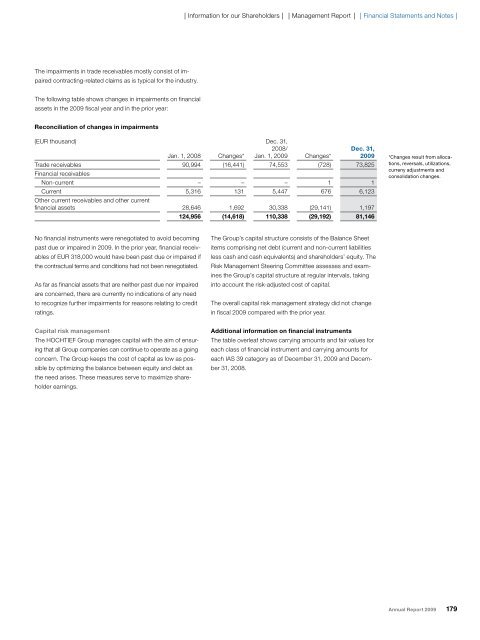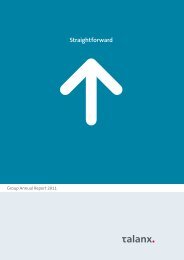ONE ROOF
ONE ROOF
ONE ROOF
Create successful ePaper yourself
Turn your PDF publications into a flip-book with our unique Google optimized e-Paper software.
The impairments in trade receivables mostly consist of im-<br />
paired contracting-related claims as is typical for the industry.<br />
The following table shows changes in impairments on financial<br />
assets in the 2009 fiscal year and in the prior year:<br />
Reconciliation of changes in impairments<br />
No financial instruments were renegotiated to avoid becoming<br />
past due or impaired in 2009. In the prior year, financial receivables<br />
of EUR 318,000 would have been past due or impaired if<br />
the contractual terms and conditions had not been renegotiated.<br />
As far as financial assets that are neither past due nor impaired<br />
are concerned, there are currently no indications of any need<br />
to recognize further impairments for reasons relating to credit<br />
ratings.<br />
Capital risk management<br />
The HOCHTIEF Group manages capital with the aim of ensuring<br />
that all Group companies can continue to operate as a going<br />
concern. The Group keeps the cost of capital as low as possible<br />
by optimizing the balance between equity and debt as<br />
the need arises. These measures serve to maximize shareholder<br />
earnings.<br />
❘ Information for our Shareholders ❘ ❘ Management Report ❘ ❘ Financial Statements and Notes ❘<br />
(EUR thousand)<br />
Dec. 31,<br />
2008/<br />
Dec. 31,<br />
Jan. 1, 2008 Changes* Jan. 1, 2009 Changes* 2009<br />
Trade receivables<br />
Financial receivables<br />
90,994 (16,441) 74,553 (728) 73,825<br />
Non-current – – – 1 1<br />
Current<br />
Other current receivables and other current<br />
5,316 131 5,447 676 6,123<br />
financial assets 28,646 1,692 30,338 (29,141) 1,197<br />
124,956 (14,618) 110,338 (29,192) 81,146<br />
The Group’s capital structure consists of the Balance Sheet<br />
items comprising net debt (current and non-current liabilities<br />
less cash and cash equivalents) and shareholders’ equity. The<br />
Risk Management Steering Committee assesses and examines<br />
the Group’s capital structure at regular intervals, taking<br />
into account the risk-adjusted cost of capital.<br />
The overall capital risk management strategy did not change<br />
in fiscal 2009 compared with the prior year.<br />
Additional information on financial instruments<br />
The table overleaf shows carrying amounts and fair values for<br />
each class of financial instrument and carrying amounts for<br />
each IAS 39 category as of December 31, 2009 and December<br />
31, 2008.<br />
*Changes result from allocations,<br />
reversals, utilizations,<br />
curreny adjustments and<br />
consolidation changes.<br />
Annual Report 2009 179
















